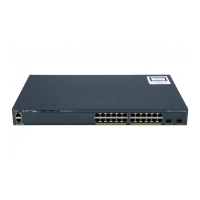When you enable the DHCP snooping information option 82 on the switch, the following sequence of
events occurs:
•
The host (DHCP client) generates a DHCP request and broadcasts it on the network.
•
When the switch receives the DHCP request, it adds the option-82 information in the packet. By default,
the remote-ID suboption is the switch MAC address, and the circuit-ID suboption is the port identifier,
vlan-mod-port, from which the packet is received.You can configure the remote ID and circuit ID.
•
If the IP address of the relay agent is configured, the switch adds this IP address in the DHCP packet.
•
The switch forwards the DHCP request that includes the option-82 field to the DHCP server.
•
The DHCP server receives the packet. If the server is option-82-capable, it can use the remote ID, the
circuit ID, or both to assign IP addresses and implement policies, such as restricting the number of IP
addresses that can be assigned to a single remote ID or circuit ID. Then the DHCP server echoes the
option-82 field in the DHCP reply.
•
The DHCP server unicasts the reply to the switch if the request was relayed to the server by the switch.
The switch verifies that it originally inserted the option-82 data by inspecting the remote ID and possibly
the circuit ID fields. The switch removes the option-82 field and forwards the packet to the switch port
that connects to the DHCP client that sent the DHCP request.
•
In the default suboption configuration, when the described sequence of events occurs, the values in these
fields do not change (see the illustration,Suboption Packet Formats):
•
Circuit-ID suboption fields
◦
Suboption type
◦
Length of the suboption type
◦
Circuit-ID type
◦
Length of the circuit-ID type
•
Remote-ID suboption fields
◦
Suboption type
◦
Length of the suboption type
◦
Remote-ID type
◦
Length of the remote-ID type
In the port field of the circuit ID suboption, the port numbers start at 3. For example, on a switch with 24
10/100/1000 ports and four small form-factor pluggable (SFP) module slots, port 3 is the Gigabit Ethernet
1/0/1 port, port 4 is the Gigabit Ethernet 1/0/2 port, and so forth. Port 27 is the SFP module slot Gigabit
Ethernet1/0/25, and so forth.
The illustration, Suboption Packet Formats. shows the packet formats for the remote-ID suboption and the
circuit-ID suboption when the default suboption configuration is used. For the circuit-ID suboption, the module
Catalyst 2960-XR Switch Security Configuration Guide, Cisco IOS Release 15.0(2)EX1
168 OL-29434-01
Configuring DHCP
Option-82 Data Insertion

